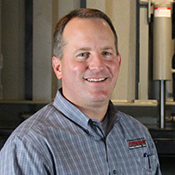Why Isn’t Your Loading Dock Connected to Your Supply Chain?
Brett Lindstrom and Jeff Schulze of Systems, LLC, discuss streamlining the supply chain through better loading dock connectivity and efficiency.

While much attention is paid to the area within a warehouse’s four walls and to the routes that shipments take as they make their way to a customer’s location, the loading dock isn’t much of a focal point for companies operating in today’s fast-paced distribution environment.
In this Insider Q&A, Lindstrom and Schulze show the benefits of “connecting” a loading dock to the end-to-end supply chain and show how this simple step can result in major efficiencies, improved safety, and serious productivity improvements.
Q: What’s the current operating environment in today’s warehouse and DC operations?
SCHULZE: We’re seeing a growing demand for efficiency and for the metrics needed to track that efficiency. Not long ago, companies still used dry erase boards and other manual tools to track their loading dock schedules. Others relied mainly on instinct to assess the efficiency levels of, say, their forklift drivers. Fast-forward to 2020 and we’re seeing more companies utilizing technology to gain efficiencies, streamlined processes, and maintain safer operations both in and out of their warehouses. Even at a consumer level, we see people investing in Nest thermostats and myQ garage door openers for their homes. They want to know what’s going on, how they can improve, and which issues are sneaking through the cracks. Technology is helping them address that.
Q: What are some of the biggest challenges facing warehouse/DC operations right now?
LINDSTROM: For many companies, the loading dock is the bottleneck of their entire operation. There’s a lot of effort being put into making warehouses and DCs more efficient throughout their entire operations—including inventory, workflows, and so forth—but when it comes to the loading dock, companies kind of lose sight of that. As a result, the dock becomes this “black hole” of poor visibility where no one really knows what’s going on. Then, that visibility picks back up again when it comes time to track shipments as they move through the supply chain. Dock bottlenecks are a major challenge for facilities, many of which are now looking to implement technology to help alleviate those issues.
Q:What are the dangers of not seeing the loading dock as a key link in the supply chain?
SCHULZE: The dock is one of those things that people take for granted until it’s not working the way that it’s supposed to work. For the most part, if loading dock equipment doesn’t work, there’s no products being shipped because everything that’s produced either comes in or leaves through a loading dock. Through better monitoring of the dock—and by knowing when it’s time for preventative maintenance, repair, or adjustment of cycle counts—companies can better leverage their docks and ensure much smoother and more reliable shipping and receiving.
Q: What role does technology play in stepping up dock visibility?
LINDSTROM: Most warehouses or DCs have some type of warehouse management system (WMS), enterprise resource planning platform (ERP), or yard management system (YMS). They assume that this software covers their entire operation, but to truly obtain visibility throughout every step of the process of your operations, they also need visibility at the dock. Why leave that one space blank?
SCHULZE: Our application can send a text message to a maintenance person when a fault occurs, thus ensuring that he or she can proactively trek across the one million-square-foot warehouse to make the repair before someone even detects the problem. This capability alone translates into less downtime and better dock utilization.
From a safety standpoint, our technology keeps track of and notifies safety directors when people are using safety equipment like truck restraints. Rather than wait until a problem occurs, those directors can proactively say, “We know that we’re currently restraining 80% of the trucks. What do we need to do to move that up to 90% or 95%? Can we get notifications sent anytime somebody on the floor enters bypass mode instead of using the truck restraints that are installed?”
Q: What does dock connectivity look like in action?
SCHULZE: It’s using technology to make the correlation between the loading dock and other activities taking place in the warehouse or DC—the kind of interactions that previously could only be correlated through people (or, by having somebody actually observe and take notes). For example, a company can use connected technologies to figure out the correlation between energy usage and doors opening and closing.
By tracking the percentage of time that dock doors are spent open when temperatures are extremely hot or cold—and by making the necessary adjustment— companies can rack up substantial savings on their heating and cooling bills (while also operating in a more environmentally-conscious manner).
LINDSTROM: With connectivity, companies can also correlate demurrage fees and waiting time for trucks at the dock. Knowing that a truck was released at a specific time, for example, enables companies to manage that time against potential demurrage fees and to leverage data in a way that strengthens their entire dock management approaches. These metrics also help companies position themselves as “shippers of choice” with carriers that want to do business with customers that put the time and effort into streamlining their shipping operations.
Q: How can a warehouse operation gain these levels of connectivity?
LINDSTROM: It’s about connecting physical devices to the cloud and automating the data collection process. That automation is based on sensors that are installed on the dock and in the warehouse. These sensors effectively remove the human error of manually tracking “when something happened” or “when this event occurred.” The sensors detect the activity, gather the data, and then send it to a gateway or hub connected to the cloud. With these components in place, companies can begin gathering the insights that they need to improve their dock operations.
Q: What do companies get in return for the investments in dock connectivity technology?
SCHULZE: Energy efficiency and food security are two of the top benefits that companies can expect. For example, they can not only tell their customers that they’re doing everything that they can to protect the food, but they can actually show them what they’re doing (i.e., how often the dock doors are open, how long it takes us to service a truck, the timespan from when a truck arrives to the time it leaves, etc.).
This is important because if a truck sits for 20 minutes—and if it only takes 10 minutes to unload—then for the other 10 minutes it may be sitting open, losing temperature, and being exposed to insects. There’s also a cost savings associated with monitoring the efficiency of the loading dock and the amount of energy that’s lost or gained by operating efficiently. Finally, it improves monitoring and maintenance, both of which result in less downtime. And less downtime means more money.
Q: Which overarching benefit of dock connectivity stands out above the rest?
LINDSTROM: It’s the efficiency that comes from actually “seeing” what your average load times are, and then narrowing that down into each individual dock and looking at your average load time at each individual dock. If the truck is there for 30 minutes, but you were only loading it for 10 minutes, what’s going on? How can you correct that? When companies use technology to answer these questions and make the necessary adjustments, the benefits begin to surface pretty quickly.
SCHULZE: Notifications are a game changer in this industry, where users are notified when a truck pulls in, when a truck leaves, when a truck is sitting for too long, or when it’s not being loaded/unloaded efficiently. This levels the playing field for small to midsized operators that may not have an ERP or YMS in place, but need good oversight of what’s going on outside of the four walls of their warehouses.
Q: What else should warehouse managers know about future trends in dock connectivity and monitoring?
SCHULZE: The possibilities are endless. Credentialing, video, and various other modern technologies still haven’t even touched the loading dock area yet. Using these innovations, companies will be able to gather even more data, monitor even more of their operations, and use those innovations to follow and track trucks from the time they enter the gate until the time they leave. Throughout that whole process, notifications will keep the appropriate parties informed about those specific moves while providing insights about the operation as a whole.
LINDSTROM: When it comes to the loading dock, we’re only at the tip of the iceberg in terms of technology and connectivity. Where the inside of the warehouse has been using barcoding and other types of automation for years, the loading dock is just now catching up to that. With our iDock Connect software, we’re helping companies leverage the Internet of Things (IoT) and other advanced technologies on the dock. This is only going to expand and progress over the next few years.
 Brett Lindstrom,
Brett Lindstrom,
Director of Marketing
and Connected Experience
 Jeff Schulze,
Jeff Schulze,VP of National Account Sales
at Systems, LLC,
the manufacturer of Poweramp, DLM,
and McGuire loading dock equipment.

Article Topics
Columns News & Resources
New resource center for weighing and dimensioning Protective packaging roundup MODEX C-Suite Q&A: Troy Donnelly, Senior VP of Sales, Marketing, and Application, DMW&H When Just-in-Time Just Doesn’t Work Recycling coastline plastic into premium reusable packaging Fresh food, anyone? RPCs protect in the supply chain Why Isn’t Your Loading Dock Connected to Your Supply Chain? More ColumnsLatest in Materials Handling
The (Not So) Secret Weapons: How Key Cabinets and Asset Management Lockers Are Changing Supply Chain Operations MODEX C-Suite Interview with Harold Vanasse: The perfect blend of automation and sustainability Consultant and industry leader John M. Hill passes on at age 86 Registration open for Pack Expo International 2024 Walmart chooses Swisslog AS/RS and software for third milk processing facility NetLogistik partners with Vuzix subsidiary Moviynt to offer mobility solutions for warehouses Materials Handling Robotics: The new world of heterogeneous robotic integration More Materials HandlingSubscribe to Materials Handling Magazine

Find out what the world's most innovative companies are doing to improve productivity in their plants and distribution centers.
Start your FREE subscription today.
April 2024 Modern Materials Handling

Latest Resources










